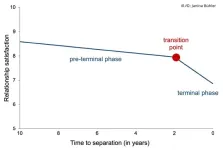Four advances that could change tuberculosis treatment
2025-03-21
(Press-News.org) As of early 2025, tuberculosis cases are increasing in the U.S. This disease, often shortened to TB, causes significant lung damage and, if not treated, is almost always lethal. World TB Day on March 24 raises awareness about the disease and commemorates Robert Koch’s discovery of the source bacterium Mycobacterium tuberculosis. More than a century later, scientists continue refining TB diagnosis methods and treatment strategies, some of which are in these four ACS journal articles. Reporters can request free access to these papers by emailing newsroom@acs.org.
Fluorescence for a faster TB diagnosis. Currently, testing saliva samples for M. tuberculosis is time-consuming because of the bacterium’s slow growth and resistance to stains used in imaging. To develop a faster method, researchers targeted a protein that the bacterium uses to steal iron ions from its host’s cells. In a study published in ACS Central Science, the team explains how to label the iron-transporter protein with a fluorescent tag, which turns on after releasing the iron inside the M. tuberculosis cells. In separate tests on saliva from 11 people diagnosed with TB, the fluorescence technique identified infectious levels of the bacterium within 10 minutes.
White blood cell-focused M. tuberculosis therapy. A type of white blood cell called a macrophage gets taken over during a tuberculosis infection, becoming an incubator for the pathogen. So, researchers report in ACS Infectious Diseases that they have developed sugar-coated nanoparticles that get absorbed by infected macrophages. And once inside, the nanoparticles interrupted critical cellular pathways and prompted the damaged cells to be recycled. In infected mice, 6 weeks of nanoparticle treatment significantly reduced the amount of M. tuberculosis in the lungs.
A potential nasal treatment for tuberculous meningitis. If M. tuberculosis reaches cerebrospinal fluid, the result can be tuberculous meningitis — a life-threatening inflammation around a person’s brain and spinal cord. To get the TB drug clofazimine across the blood-brain barrier, researchers have encapsulated it inside tiny particles and created a nasal spray. According to their study in ACS infectious Diseases, the spray didn’t adversely affect mice with tuberculous meningitis. A 4-week treatment significantly reduced the bacterial burden within the animals’ brains and lungs compared to untreated mice.
Light-activated particles inactivate bacteria. Many new TB cases are multidrug resistant. So, a research team wanted to improve treatment efficacy and reduce the risk of further antimicrobial resistance by creating a photoreactive therapy. They encapsulated light-activated particles inside nanometer-wide spheres. When the nanospheres were injected into mice, red laser light triggered the particles to produce reactive oxygen species that inactivated Mycobacterium marinum, a bacterium that causes TB-like illness in fish. The initial animal study results are published in ACS Omega.
Additionally in March 2025, ACS Webinars and ACS Publications co-hosted a virtual event, “Disrupt & Destroy: Starving Tuberculosis with Smarter Science,” about innovative drug strategies and cutting-edge TB research. The webinar is available to watch on demand.
###
The American Chemical Society (ACS) is a nonprofit organization founded in 1876 and chartered by the U.S. Congress. ACS is committed to improving all lives through the transforming power of chemistry. Its mission is to advance scientific knowledge, empower a global community and champion scientific integrity, and its vision is a world built on science. The Society is a global leader in promoting excellence in science education and providing access to chemistry-related information and research through its multiple research solutions, peer-reviewed journals, scientific conferences, e-books and weekly news periodical Chemical & Engineering News. ACS journals are among the most cited, most trusted and most read within the scientific literature; however, ACS itself does not conduct chemical research. As a leader in scientific information solutions, its CAS division partners with global innovators to accelerate breakthroughs by curating, connecting and analyzing the world’s scientific knowledge. ACS’ main offices are in Washington, D.C., and Columbus, Ohio.
Registered journalists can subscribe to the ACS journalist news portal on EurekAlert! to access embargoed and public science press releases. For media inquiries, contact newsroom@acs.org.
Note: ACS does not conduct research but publishes and publicizes peer-reviewed scientific studies.
Follow us: Facebook | LinkedIn | Instagram
END
ELSE PRESS RELEASES FROM THIS DATE:
2025-03-21
March 19, 2025 — Today, the Obesity Action Coalition (OAC) and The Obesity Society (TOS) sent a letter to the U.S. Food & Drug Administration (FDA), along with more than 20 leading organizations and providers across the healthcare continuum, urging the agency to enforce federal regulations around compounding following the recent resolution of GLP-1 medicine shortages. Among the signatories include: the Alliance for Women’s Health & Prevention, the Association of Black Cardiologists, the National Hispanic Medical Association and the National Consumers League.
The letter follows recent announcements from the FDA that Eli Lilly’s ...
2025-03-21
AMR occurs when disease-causing bacteria, viruses, fungi and parasites (pathogens) are no longer affected by the medicines that have been developed to target them. Drug-resistant pathogens can cause infections that are difficult or impossible to treat; they increase the risk of disease spread and can lead to severe illness, disability and death.
Wastewater is commonly contaminated with antimicrobial resistant micro-organisms and antimicrobial compounds. Upon entering our environment, such as rivers and seas, contaminated wastewater therefore serves as a pathway for, and major contributor to, the spread of AMR in the UK and ...
2025-03-21
The end of a romantic relationship usually does not come out of the blue but is indicated one or two years before the breakup. As the results of a psychological study have demonstrated, the terminal stage of a relationship consists of two phases. First, there is a gradual decline in relationship satisfaction, reaching a transition point one to two years before the dissolution of the relationship. "From this transition point onwards, there is a rapid deterioration in relationship satisfaction. Couples in question then move towards separation," said Professor ...
2025-03-21
In a groundbreaking study on the synthesis of cellulose – a major constituent of all plant cell walls – a team of Rutgers University-New Brunswick researchers has captured images of the microscopic process of cell-wall building continuously over 24 hours with living plant cells, providing critical insights that may lead to the development of more robust plants for increased food and lower-cost biofuels production.
The discovery, published in the journal Science Advances, reveals a dynamic process never seen before and may provide practical applications for everyday products derived from plants including ...
2025-03-21
A research team led by Mount Sinai has uncovered mechanisms of abnormal immune cell function that may lead to Crohn’s disease, according to findings published in Science Immunology on March 21. The researchers said their discovery provides better understanding of disease development and could inform the development and design of new therapies to prevent inflammation before it starts in the chronic disorder.
Crohn’s disease is an inflammatory bowel disease (IBD) that causes chronic inflammation of the gastrointestinal (GI) tract, and symptoms can include abdominal ...
2025-03-21
A liquid robot capable of transforming, separating, and fusing freely like living cells has been developed.
Seoul National University College of Engineering announced that a joint research team led by Professor Ho-Young Kim from the Department of Mechanical Engineering, Professor Jeong-Yun Sun from the Department of Materials Science and Engineering, and Professor Keunhwan Park from the Department of Mechanical, Smart, and Industrial Engineering at Gachon University has successfully developed a next-generation ...
2025-03-21
Freshwater ecosystems require adequate oxygen levels to sustain aerobic life and maintain healthy biological communities. However, both long-term climate warming and the increasing frequency and intensity of short-term heatwaves are significantly reducing surface dissolved oxygen (DO) levels in lakes worldwide, according to a new study published in Science Advances.
Led by Prof. SHI Kun and Prof. ZHANG Yunlin from the Nanjing Institute of Geography and Limnology of the Chinese Academy of Sciences, in collaboration with researchers from the Nanjing University and the UK’s ...
2025-03-21
Peking University, March 19, 2025: The research group led by Prof. Wang Chu from the College of Chemistry and Molecular Engineering at Peking University published a research article entitled “Quantitative Chemoproteomics Reveals Dopamine’s Protective Modification of Tau” in Nature Chemical Biology (DOI:10.1038/s41589-025-01849-9). Using a novel quantitative chemoproteomic strategy, the team uncovered a protective role of dopamine (DA) in regulating the function of the microtubule-associated protein Tau. This discovery deepens our understanding of dopamine’s physiological and pathological roles in the human brain.
Why it matters:
1. Dopamine, ...
2025-03-21
A federally funded research team led by Sheri Holmen, PhD, investigator at Huntsman Cancer Institute and professor in the Department of Surgery at the University of Utah (the U), is testing a new combination drug therapy that could both treat and prevent melanoma metastasis, or spreading from its original site, to the brain.
“Once melanoma has spread to the brain, it’s very hard to treat. Metastasis to the brain is one of the main causes of death from melanoma,” says Holmen. “We wanted to find a solution to an unmet clinical need for those patients who had no other treatment options ...
2025-03-21
Peking University, March 20, 2025: A groundbreaking study led by Li Yi, professor at the School of Life Sciences, was published in Nature on March 12, titled “Perception of viral infections and initiation of antiviral defence in rice”, uncovering a molecular mechanism by which rice cells perceive viral infections and initiate antiviral response, which significantly contributes to understanding of virus-host interactions for further disease resistance breeding.
Why it matters:
Viruses affecting rice, a staple food for more than half of the world population, pose ...
LAST 30 PRESS RELEASES:
[Press-News.org] Four advances that could change tuberculosis treatment



